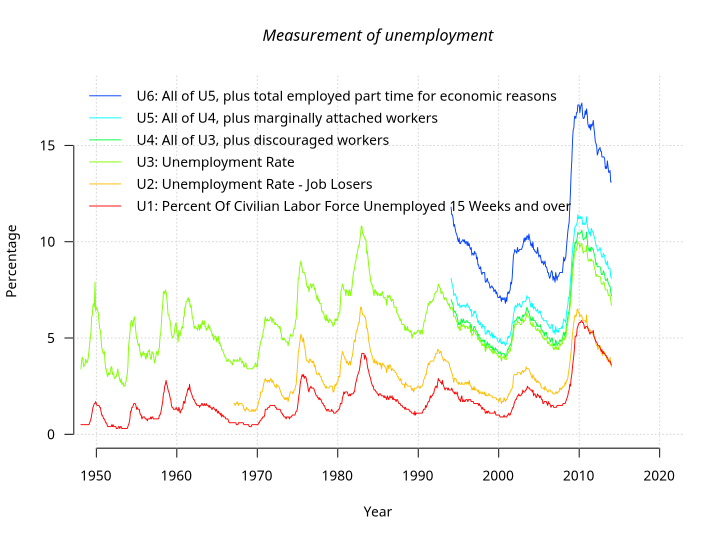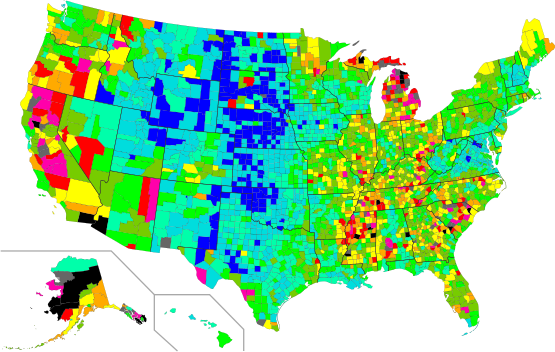22.2: Measuring Unemployment
- Last updated
- Save as PDF
- Page ID
- 4467

- Boundless
- Boundless
Measuring the Unemployment Rate
The labor force is the actual number of people available for work; economists use the labor force participation rate to determine the unemployment rate.
learning objectives
- Classify the six measures of unemployment calculated by the Bureau of Labor Statistics (BLS)
Unemployment Rate
Unemployment occurs when people are without work and are actively seeking employment. In an economy, the labor force is the actual number of people available for work. Economists use the labor force participation rate to determine the unemployment rate.
Unemployment can be broken down into three types of unemployment:
- Cyclical unemployment: occurs when there is not enough aggregate demand in the economy to provide jobs for everyone who wants to work.
- Structural unemployment: occurs when the labor market is unable to provide jobs for everyone who wants to work. There is a mismatch between the skills of the unemployed workers and the skills necessary for the jobs available.
- Frictional unemployment: the time period between jobs when a worker is looking for a job or transitioning from one job to another.
Measuring Unemployment
The U.S. Bureau of Labor Statistics measures employment and unemployment for individuals over the age of 16. The unemployment rate is measured using two different labor force surveys.
- The Current Population Survey (CPS): also known as the “household survey” the CPS is conducted based on a sample of 60,000 households. The survey measures the unemployment rate based on the ILO definition.
- The Current Employment Statistics Survey (CES): also known as the “payroll survey” the CES is conducted based on a sample of 160,000 businesses and government agencies that represent 400,000 individual employees.
The unemployment rate is also calculated using weekly claims reports for unemployed insurance. The government provides this data. The unemployment rate is updated on a monthly basis.
Six Measures of Unemployment
The U.S. Bureau of Labor Statistics uses six measurements when calculating the unemployment rate. The measures range from U1 – U6 and were reported from 1950 through 2010. They calculate different aspects of unemployment. The measures are:

Unemployment Rate: The U.S. Bureau of Labor Statistics used the six employment measures to calculate the unemployment rate in the United States from 1950 to 2010.
- U1: the percentage of labor force unemployed for 15 weeks or longer.
- U2: the percentage of labor force who lost jobs or completed temporary work.
- U3: the official unemployment rate that occurs when people are without jobs and they have actively looked for work within the past four weeks.
- U4: the individuals described in U3 plus “discouraged workers,” those who have stopped looking for work because current economic conditions make them think that no work is available for them.
- U5: the individuals described in U4 plus other “marginally attached workers,” “loosely attached workers,” or those who “would like” and are able to work, but have not looked for work recently.
- U6: the individuals described in U5 plus part-time workers who want to work full-time, but cannot due to economic reasons, primarily underemployment.
Shortcomings of the Measurement
Unemployment is not an absolute calculation and it is prone to errors and biases related to data assembly and inconsistencies in reporting.
learning objectives
- Describe the rates in the U.S. of those who are employed, unemployed, and not in the labor force
Unemployment
Unemployment, also called joblessness, occurs when people are without work and are actively seeking employment. Unemployment is measured in order to determine the unemployment rate. The rate is a percentage that is calculated by dividing the number of unemployed individuals by the number of individuals currently employed in the labor force.

U.S. Unemployment Rate: This image shows the unemployment rates by county throughout the United States in 2008. The unemployment rate is the percentage of unemployment calculated by dividing the number of unemployed individuals by the number of individuals currently employed in the labor force.
Measurements
In order to find the rate of unemployment, four methods are used:
- Labor Force Sample Surveys: provide the most comprehensive results. Calculates unemployment by different categories such as race and gender. This method is the most internationally comparable.
- Official Estimates: combines information from the three other methods. The method is not the preferred method to use when calculating the rate of unemployment.
- Social Insurance Statistics: these statistics are calculated based on the number of individuals receiving unemployment benefits. The method is criticized because unemployment benefits can expire before an individual finds employment which makes the calculations inaccurate.
- Employment Office Statistics: only include a monthly total of unemployed individuals who enter unemployment offices. This method is the least effective for measuring unemployment.
Measurement Shortcomings
The measurement of unemployment is not an absolute calculation and is prone to errors. For example, the unemployment rate does not take into account individuals who are not actively seeking employment, such as individuals attending college or even individuals who are in U.S. prisons. Individuals who are self-employed, those who were forced to take early retirement, those with disability pensions who would like to work, and those who work part-time and seek full-time employment are not factored in to the unemployment rate. Some individuals also choose not to enter the labor force and these statistics are also not considered. By not including all underemployed or unemployed individuals in the measurement of the unemployment rate, the calculation does not provide an accurate assessment of how unemployment truly impacts society. Errors and biases are also present due to data assembly and reporting inconsistencies.
Typical Lengths of Unemployment
Short-term unemployment is any period of joblessness that lasts fewer than 27 weeks. Long-term unemployment lasts 27 or more weeks.
learning objectives
- Distinguish between short-term and long-term unemployment and the impact on people and economy
Unemployment
Unemployment, also referred to as joblessness, occurs when people are without work and actively seeking employment. Generally, unemployment is high during recessions. Individuals struggle to find work when there are more job-seekers than vacant positions.
There are three types of unemployment:
- Cyclical: occurs when there is not enough aggregate demand in the economy to provide jobs for everyone who wants to work. The demand for most goods and services declines, less production is needed, and fewer workers are needed. Wages are sticky and do not fall to meet the equilibrium level which results in mass unemployment.
- Structural: occurs when the labor market is not able to provide jobs for everyone who wants to work. There is a mismatch between the skills of the workers and the skills needed for the jobs that are available.Structural unemployment is similar to frictional unemployment, but it lasts longer.
- Frictional: when a worker is searching for a job or transitioning from one job to another. Frictional unemployment is always present in an economy.
Lengths of Unemployment
Short-term unemployment is considered any unemployment period that lasts less than 27 weeks. The unemployment period is temporary and often includes the time needed to switch from one job to another. Also, if an individual is searching for employment the search period is relatively short.
Long-term unemployment is classified as unemployment that lasts for 27 weeks or longer. Being unemployed for a long period of time can have substantial impacts on individuals. Jobs skills, certifications, and qualifications lessen over time. When the job market finally increases many individuals will no longer match the requirements for the new positions. Long-term unemployment can also result in older workers taking early retirement.
.png?revision=1&size=bestfit&width=680&height=423)
Average Length of Unemployment: This graph shows the average length of unemployment in the United States from 1950-2010. Short-term unemployment is considered less than 27 weeks, while long-term unemployment is joblessness that lasts 27 weeks or longer.
Social and Individual Impacts
Unemployment can have lasting impacts of individual people as well as the economy as a whole.
- Social: Within the economy, long-term unemployment increases the inequality present in the economy and impedes long-run economic growth. Unemployment wastes resources and generates redistributive pressures and distortions within the economy. When unemployment is high, the economy is not using all of the available resources, specifically labor. Unemployment can also reduce the efficiency of the economy because unemployed workers are willing to accept employment that is below their skill level.
- Individual: For individual people, unemployment increases poverty, creates poor labor mobility, and impacts self-esteem. When individuals are unemployed they are unable to meet their financial obligations. It is not uncommon for social unrest and conflict that get worse during times of mass unemployment.
Key Points
- Unemployment occurs when people are without work and are actively seeking employment.
- There are three types of unemployment: cyclical, structural, and frictional.
- The CPS and CES are two surveys that the U.S. Bureau of Labor Statistics uses to determine the unemployment rate for households, businesses, and government agencies.
- The U.S. Bureau of Labor Statistics uses six measurements when calculating the unemployment rate. The measures range from U1 – U6 and were reported from 1950 through 2010. They calculate different aspects of unemployment.
- The rate of unemployment is a percentage that is calculated by dividing the number of unemployed individuals by the number of individuals currently employed in the work force.
- The rate of unemployment is calculated using four methods: the Labor Force Sample Surveys, Official Estimates, Social Insurance Statistics, and Employment Office Statistics.
- The measurement of unemployment does have some shortcomings based on who is and is not measured.
- By not including all under-employed or unemployed individuals in the measurement of the unemployment rate, the calculation does not provide an accurate assessment of how unemployment truly impacts society.
- Unemployment occurs when people are without work and are actively seeking employment.
- Unemployment impacts the economy and society by increasing inequality, impeding long-term economic growth, wasting resources, and reducing economic efficiency.
- Unemployment impacts individuals because they are not able to meet their financial obligations which can lead to poverty, poor labor mobility, and low self-esteem. Unemployment is also know to cause civil unrest and conflict.
Key Terms
- unemployment: The state of being jobless and looking for work.
- labor force: The collective group of people who are available for employment, i.e. including both the employed and the unemployed.
- poverty: The quality or state of being poor or indigent; want or scarcity of means of subsistence; indigence; need.
LICENSES AND ATTRIBUTIONS
CC LICENSED CONTENT, SHARED PREVIOUSLY
- Curation and Revision. Provided by: Boundless.com. License: CC BY-SA: Attribution-ShareAlike
CC LICENSED CONTENT, SPECIFIC ATTRIBUTION
- Unemployment. Provided by: Wikipedia. Located at: en.Wikipedia.org/wiki/Unemplo...bor_statistics. License: CC BY-SA: Attribution-ShareAlike
- Unemployment. Provided by: Wikipedia. Located at: en.Wikipedia.org/wiki/Unemployment. License: CC BY-SA: Attribution-ShareAlike
- Labor force. Provided by: Wikipedia. Located at: en.Wikipedia.org/wiki/Labor_force. License: CC BY-SA: Attribution-ShareAlike
- Boundless. Provided by: Boundless Learning. Located at: www.boundless.com//economics/...n/unemployment. License: CC BY-SA: Attribution-ShareAlike
- US Unemployment measures. Provided by: Wikipedia. Located at: en.Wikipedia.org/wiki/File:US_Unemployment_measures.svg. License: CC BY-SA: Attribution-ShareAlike
- Unemployment. Provided by: Wikipedia. Located at: en.Wikipedia.org/wiki/Unemployment. License: CC BY-SA: Attribution-ShareAlike
- Boundless. Provided by: Boundless Learning. Located at: www.boundless.com//economics/...n/unemployment. License: CC BY-SA: Attribution-ShareAlike
- labor force. Provided by: Wiktionary. Located at: en.wiktionary.org/wiki/labor_force. License: CC BY-SA: Attribution-ShareAlike
- US Unemployment measures. Provided by: Wikipedia. Located at: en.Wikipedia.org/wiki/File:US_Unemployment_measures.svg. License: CC BY-SA: Attribution-ShareAlike
- USA 2008 unemployment by county. Provided by: Wikipedia. Located at: en.Wikipedia.org/wiki/File:USA_2008_unemployment_by_county.svg. License: CC BY-SA: Attribution-ShareAlike
- Unemployment. Provided by: Wikipedia. Located at: en.Wikipedia.org/wiki/Unemployment. License: CC BY-SA: Attribution-ShareAlike
- Unemployment. Provided by: Wikipedia. Located at: en.Wikipedia.org/wiki/Unemployment. License: CC BY-SA: Attribution-ShareAlike
- poverty. Provided by: Wiktionary. Located at: en.wiktionary.org/wiki/poverty. License: CC BY-SA: Attribution-ShareAlike
- Boundless. Provided by: Boundless Learning. Located at: www.boundless.com//economics/...n/unemployment. License: CC BY-SA: Attribution-ShareAlike
- US Unemployment measures. Provided by: Wikipedia. Located at: en.Wikipedia.org/wiki/File:US_Unemployment_measures.svg. License: CC BY-SA: Attribution-ShareAlike
- USA 2008 unemployment by county. Provided by: Wikipedia. Located at: en.Wikipedia.org/wiki/File:USA_2008_unemployment_by_county.svg. License: CC BY-SA: Attribution-ShareAlike
- US average duration of unemployment. Provided by: Wikipedia. Located at: en.Wikipedia.org/wiki/File:US_average_duration_of_unemployment.png. License: CC BY-SA: Attribution-ShareAlike

